Mike Vardy's Blog, page 50
March 4, 2019
The Non-Linear Way
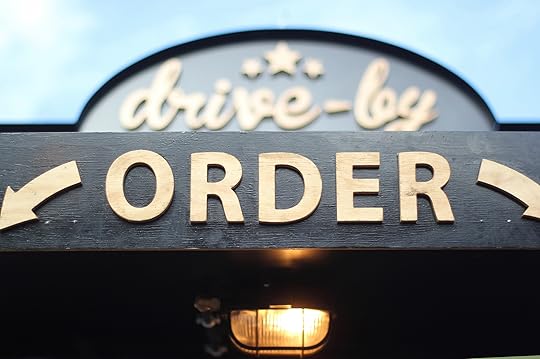
Have you ever looked at time in a non-linear way?
I’m watching Pulp Fiction right now. The way the film is constructed is different than most films. The film is delivered in a non-linear fashion. All of the stories unfold into each other and on top of each other. Characters intersect and the endgame for one of them is surprisingly revealed well before the film ends. (Spoiler alert: he dies two-thirds into the presentation of the film but appears alive in the final sequence because of the way the film is presented.)
The way our days are delivered seem to be linear. Seconds, minutes, hours pass. But the things we do within that time are delivered largely in a nonlinear way. Or, at the very least, can be delivered as such.
When we look at our to do lists, they are sequential in one way or another. Oftentimes sequence is displayed in the order the to do items were written down into the first place. But working in that sequence isn’t always the most productive. More often, it’s detrimental to our productivity. But it seems easier to tackle the list that way because it’s the way it is presented to us in that moment. It’s the way it’s presented to us throughout the day.
Today instead of tackling your to do list from top to bottom, attack it in a non-linear fashion. Mix up the order so it makes more sense in your day. Do that before you start crossing things off.
Try doing things the non-linear way. It might just make your day.
The post The Non-Linear Way appeared first on Productivityist.
February 25, 2019
Gratitude First: A 30 Day Challenge

Note from Mike: Expressing gratitude can really make a difference in your productivity so rather than speak to it myself, I went to the expert, my good friend Karl Staib. Karl dedicates his attention and focus to helping others display and share gratitude. He is the author of Bring Gratitude and the creator of the 30-Day Bring Gratitude Challenge.
There were 3 important things I needed to do and I wasn’t doing any of them.
I just kept ignoring my “to do” list.
I was stuck and not used to feeling this way.
As I sat there I realized I had fallen into bad habits. I was letting my worries get the better of me.
A few years ago I added a gratitude journal to my daily habits and my procrastination significantly reduced. I had been forgetting to do this lately and I needed to get back to it.
I pulled out my journal and wrote down why I was grateful for each important task.
I’m grateful for wanting to write a blog post because it will help me reach more people with my message.
I’m grateful for the email I’m preparing to send to a potential client because I can help them bring more gratitude to their company culture.
I’m grateful to record a video for a course I’m building for my audience.
This exercise helped me bring gratitude to each task that I wanted to do. I just needed to appreciate that these were tasks that I wanted to do, not something I had to do.
Perspective
In the past, I have struggled with my health (Cancer, ulcer, stress, migraines, etc.) and it put a strain on my productivity. As I dealt with these issues, there have been lapses in my ability to get things done. As I recovered from each health issue, I realized that it was often my mindset that was holding me back.
My belief in myself suffered because I wasn’t allowing myself to see the potential positive outcome in each of my projects. I focused on all the negative that might occur.
When my father went into the hospital and eventually passed away, I saw how he struggled with his outlook and his complaining increased as he got older. I wanted to do something about it before I became a grumpy old man that everyone avoided. I wanted to be the guy people gravitated towards.
By this point, I had already read a lot of books on meditation, happiness, and self-improvement. The concept that moved the needle the most was gratitude.
I had kept a gratitude journal in the past and it helped a lot. Keeping a gratitude journal helped me focus on appreciating what I had in my life instead of worrying about what I didn’t. As I started up my gratitude journal again, I began to see my mindset shift. I could feel that gratitude was helping me not just at work, but in my relationships.
That’s when I started turning my journal entries into stories, which helped me go deeper into gratitude. These stories turned into the book Bring Gratitude, which has spurred a gratitude movement.
Gratitude
Choosing to be grateful for what I have and not feeling like I need more has resulted in a big improvement in my outlook and overall happiness.
In his book, Why We Do What We Do, researcher Edward Deci explains that when someone has six positive interactions to one negative, they are 31% more productive.
When you have positive thoughts and interactions, it’s easier to focus on what matters. That may be spending time with your family, traveling, or writing. Positive interactions free you up to have the energy to do what matters to you.
It’s this energy that will spur you to take on projects that might take you out of your comfort zone. Too often we procrastinate because we don’t want to deal with the feelings that will arise when do the work.
Positive thoughts will also make the things you don’t love doing, but are necessary to reaching your goals, a little easier to tackle. I want to be a best selling author. I’m not there yet, but I maintain confidence that I’ll be there someday. I attribute a lot of this confidence to my gratitude journal. Because I take the time to appreciate the good things in my life I notice the snowball effect of this attitude. It has helped me overcome obstacles that I wouldn’t have previously been able to overcome.
Start Small
I want you to take that first step toward strengthening your mindset, so you can be more aware of bad habits and use them to grow your happiness. Start with a gratitude journal and find a support network to help you keep building the gratitude habit. Keep it simple.
Just write what you are grateful for and why every day for 30 days. I suggest something like this:
“I’m grateful for the fresh water that comes out of my sink every morning because it makes a great cup of coffee.”
“I’m lucky to have three favorite pairs of jeans because they all fit me well.”
“I appreciate my neighbor because he always smiles and waves when he sees me.”
The “why” is important because it helps deepen the gratitude journal experience. Within a few days you will begin to see improvement in your outlook.
If you are interested, join my free 30-Day Bring Gratitude Challenge running March 1st through 30th. It’ll help strengthen your mindset. Join and you’ll get email updates and access to a private Facebook group. If you have any questions, I’ll be available 7 days a week during this time. My goal is to get the smartest and most caring people together to create an amazing community so we can help each other learn from our mistakes and build a life that we love.
The post Gratitude First: A 30 Day Challenge appeared first on Productivityist.
February 18, 2019
The Idea of Doing More vs. Doing Better
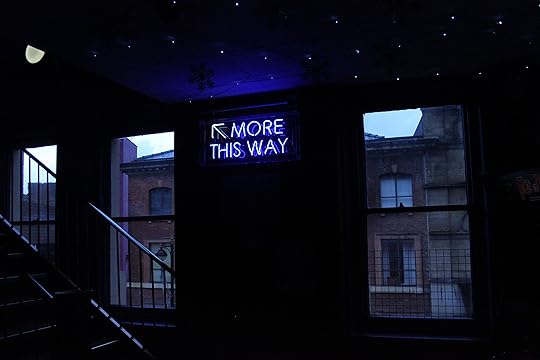
One thing that always comes to mind during the week between Christmas and New Year’s Day is the idea of doing more vs. doing better. It’s at that time of year that I have the opportunity to really look at what I’ve done over the past several months and what I look to do in the months ahead. There’s a tranquility over those seven days that is hard to find at any other time of the calendar year. So I take advantage of it.
Even after that break and having clarity of thought it’s really challenging to work towards being better at things I’m already doing as opposed to doing more things. The idea of doing more is far easier to quantify. Doing things better is more of a qualitative thing. That is more challenging to measure. I think that’s why the push to do more is prevalent in the world more than doing things better. It’s more objective. It’s something you can certainly measure easier and that means you can manage it easier.
Or can you manage it easier?
I’d suggest doing less better is easier to manage but more difficult to measure in terms of productivity – at least at first glance. The management part is simpler. Why? It’s because you are managing less things. But the measurement part needs to be tweaked so that you’re not measuring the amount of things you’re doing. Instead you’re measuring the outcomes of the things that you’re doing better.
No matter what time of year you’re reading this, think about whether it’s worth placing your focus and attention on doing more things or doing what you’re already doing better instead. Doing less things better seems to fly in the face of productivity. But if you do it right, it is the most productive thing you can do.
The post The Idea of Doing More vs. Doing Better appeared first on Productivityist.
July 4, 2018
The Evolution of Getting Things Done with David Allen
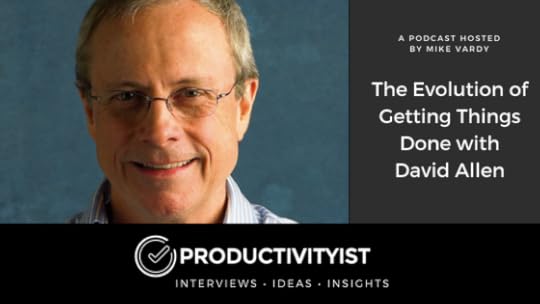
David Allen joins me on this episode of the podcast to dive deeper into the Getting Things Done methodology. The meat of our conversation gets into how it has evolved over the years since it first was introduced in 2001.
There’s a bit of noise at parts during our discussion, but even still this episode is a winner. Some of the highlights of this episode include:
How much of a role he had in writing the new book, Getting Things Done for Teens
Why he believes teens need GTD more now than ever before
A discussion about the reframing of GTD that needed to happen when adapting the methodology for teens
How he has changed his approach when teaching GTD over the years
David reveals his thoughts on the most challenging aspect of GTD (Hint: It hasn’t changed since the introduction of GTD)
A conversation surrounding the renaissance of analog tools and his thoughts on why they’ve made a comeback
Ready to check out the show? You can listen to the episode in the player below.
Here are some of the relevant links we discussed during the show:
Getting Things Done with David Allen | The Productivityist Podcast
Getting Things Done for Teens | Amazon
Getting Things Done | The David Allen Company
David Allen (@gtdguy) | Twitter
It’s always a treat to get to chat with the creator of GTD. I had a great time speaking with David and I hope you have a great time listening to our conversation.
Enjoy the show? Want to keep up with the podcast? You can subscribe to the podcast feed by clicking the “Share” button in the player above – and you can share it further using the same button as well. You can take things even one step further by rating and reviewing the show wherever you listen to podcasts. Thanks for listening and supporting the show!
The post The Evolution of Getting Things Done with David Allen appeared first on Productivityist.
June 27, 2018
Off the Clock with Laura Vanderkam
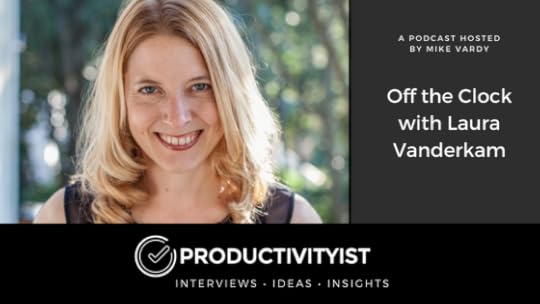
This episode is sponsored by Newton. Newton is my email app of choice…and has been for a few years now. Recently they’ve reached a massive subscriber milestone: 40,000 users! I’m one of them because Newton has everything I’ve been looking for in an email application and more! You can (and should) give Newton a test drive for 14 days by visiting http://Productivityist.com/newton/.
This week on The Productivityist Podcast, I am joined by speaker and author Laura Vanderkam. Her latest book is Off the Clock: Feel Less Busy While Getting More Things Done.
Laura’s work has appeared in various publications and media outlets including The New York Times, The Wall Street Journal, The Today Show and Fox & Friends among many others. She co-hosts the Best of Both Worlds podcast and has delivered a TED talk with more than 5 million views.
Tune in as we discuss why we always feel there’s not enough time and some mindset shifts we need to break that. We talk about people’s different perception of time, prioritizing, setting the right habits and managing your energy among other things. If you are always stressed out and can’t seem to accomplish your goals, then this episode is for you.
Relevant Links:
Laura Vanderkam’s website
Off the Clock: Feel Less Busy While Getting More Things Done | Amazon
How to Gain Control of Your Free Time | TED
Best of Both Worlds Podcast
Laura Vanderkam (@lvanderkam) | Twitter
Thanks for listening. If you enjoyed the show don’t forget to subscribe so you don’t miss a single episode. Until next time remember to stop guessing…and start going!
The post Off the Clock with Laura Vanderkam appeared first on Productivityist.
June 20, 2018
Willpower Doesn’t Work with Benjamin Hardy
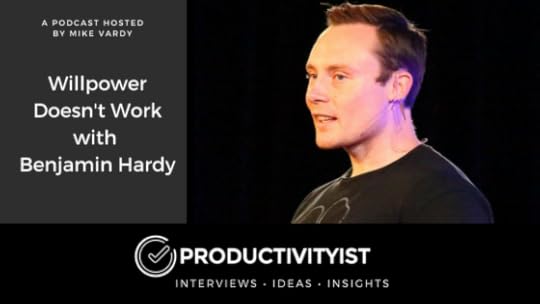
This week on the Productivityist Podcast, I am joined by Benjamin Hardy. Benjamin has been the #1 writer on Medium.com since 2016 and has organically grown his email list from 0-300,000+ subscribers in 2 years through his writings about self-improvement. His new book, Willpower Doesn’t Work came out this March.
In this episode, we dived deep into the psychology of willpower. Some topics we discussed include the dangers of relying on willpower, why it seldom works, and a better approach to productivity. We also discussed journaling as a tool for improving yourself and achieving your goals, among many other things.
Relevant Links:
Benjamin P. Hardy | Medium
Willpower Doesn’t Work by Benjamin Hardy | Medium
What You Need to Know About Willpower: Here’s What Actually Works
You Can Never Change Your Life Through Willpower: Here’s What Actually Works
Willpower Doesn’t Work: Here’s How to Actually Change Your Life
Willpower is a Myth, and Believing in it Can Make Things Worse | CBC Radio
Top Change Management Consulting Firm: Employee Engagement Solutions
Johann Hari: Everything You Think You Know About Addiction is Wrong
Home – Joe Polish
How to Write in Your Journal to Improve Yourself and Achieve Your Goals
Genius Network Events 2018
Thanks for listening. If you enjoyed the show don’t forget to subscribe so you don’t miss a single episode. Until next time remember to stop guessing…and start going!
The post Willpower Doesn’t Work with Benjamin Hardy appeared first on Productivityist.
June 13, 2018
The Direct Line Between Happiness and Productivity with Will Henshall
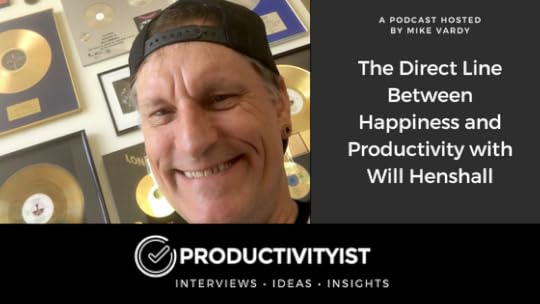
This week on the 200th(!) episode of The Productivityist Podcast my guest is Will Henshall. Will is the CEO and founder of Focus@Will, a tech music platform that helps 1.5m professionals be up to four times more productive at work.
He has had a 30 year notable career as a startup entrepreneur, tech inventor and musician. He founded the platinum-selling 90s British pop soul band Londonbeat (he wrote Billboard #1 hit songs ‘I’ve Been Thinking About You’ and ‘Come Back’). In 1996 he started up San Francisco based Rocket Network, and invented the pro audio media transfer tool ProTools DigiDelivery, used extensively in movie post-production, sold to Avid in 2003.
During our nearly hour-long conversation, we talked about the evolution of his entrepreneurial journey, attention and what distractibility has done to our productivity (and what he is doing to help combat that), the relationship between happiness and productivity, and so much more.
Relevant Links:
Focus@Will
I’ve Been Thinking About You by London Beat | YouTube
The Big 5 Personality Types | Business Insider
Can This “Neuroscience-Based” Music App Really Boost Your Brain Power by 400% | WIRED
Dr. Ned Hallowell
Driven to Distraction: Recognizing and Coping with Attention Deficit Disorder | Amazon
Ikigai The Japanese Secret to a Long and Happy Life | Amazon
Flow: The Psychology of Optimal Experience | Amazon
How to Transform A Single Daily Theme Into an Everyday Focus | Productivityist
The Power of When with Dr. Michael Breus | The Productivityist Podcast
I’ve Been Thinking About You by Good Luck | YouTube
Focus@Will (@focusatwill) | Twitter
Thanks for listening. If you enjoyed the show don’t forget to subscribe so you don’t miss a single episode. Until next time remember to stop guessing…and start going!
The post The Direct Line Between Happiness and Productivity with Will Henshall appeared first on Productivityist.
June 6, 2018
Create Good Mornings with Craig Kulyk
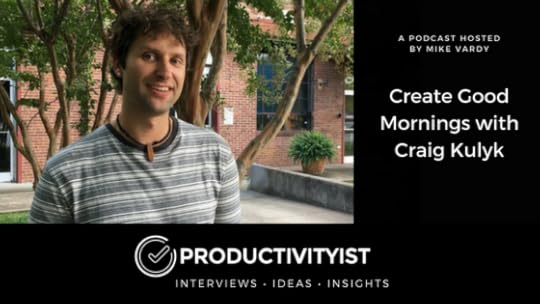
On this episode of the podcast, I spoke with Craig Kulyk. Craig writes about how to customize your morning to build better habits and be more productive. We spoke about intentionality, how routines set the tone for the day, how you can shift and adapt your rituals over time and more.
Here are a few highlights from the show:
The power of routines
Building constraints (or you find yourself eating too many cookies)
Starting points at building a routine
The idea of sunk costs
The role fear of missing out (FOMO) plays in our decision-making process
Establishing breathing room or space into your morning routines
Questions to ask that are causing challenges in your morning routine
Planning your day
The power of small changes
Different things Craig has tried in his morning routine such as meditation, fasting, etc.
Craig’s experience with the Tribe Conference
Relevant Links:
Five Simple Strategies to Customize Your Morning Routine
Start Here – Create Good Mornings
What You Can Learn from Mike Vardy About Productivityist
The Lesson of Sunk Costs (Applied to Morning Habits)
Why You Shouldn’t Spend Time Journaling in the Morning (And What You Should Do Instead)
127 Morning Rituals – The Ultimate List to Customize Morning Routine
Mike Vardy’s Morning Routine | My Morning Routine
Mike Vardy’s Evening Routine | Evening Routines
How Tribe Conference Can Change Your Life
Craig Kulyk @craigkulyk | Twitter
Thanks for listening. If you enjoyed the show don’t forget to subscribe so you don’t miss a single episode. Until next time remember to stop guessing…and start going!
The post Create Good Mornings with Craig Kulyk appeared first on Productivityist.
June 4, 2018
You Can Avoid Multitasking When You Focus on These 3 Things
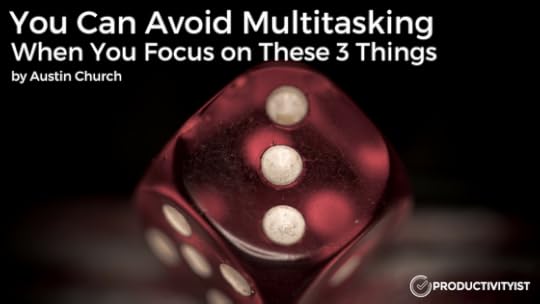
This is a guest post by Austin L. Church. Austin is a writer and consultant who runs a branding and content agency called Balernum. He lives in Knoxville, Tennessee, with his lovely and patient wife Megan, and their two boys and one girl. He would tell you that his family and his faith are the reason he is so gung-ho about improving his focus, his business, and himself. He wants his kids to say, “Go away!” not “Why is Dad always gone?” You can say hi on Twitter: @austinlchurch.
I can’t remember exactly when I first stumbled across the Covey quadrant.
You’ve probably seen it. It’s a larger square divided up into four smaller squares. You write “Urgent” in the top left and “Not Urgent” on the top right. On the left side you write “Important” above and “Not Important” below. Each task that comes to mind gets a home in one of the four boxes, and each day’s top priorities belong in the upper lefthand corner of the quadrant where Urgent and Important come together.
Dwight D. Eisenhower’s Decision Principle inspired Covey’s Quadrant, so using the quadrant system and playing air traffic controller for a Monday’s many to-dos is paying homage to two lucid thinkers and gifted leaders. I like that thought.
The problem is, the Covey Quadrant has never worked for me.
My experience went like this:
I dutifully drew my squares and penciled in my tasks—you know, because ink feels too permanent.
With head held high and swelling confidence, I strode out into my day.
One, or two, or five hours’ worth of curveballs later, the day’s tight cluster of to-dos would burst apart like a covey of quail.
My mission became taking pot shots at anything and everything with hopes that some completed task or met deadline would fall out of the sky.
Anxiety doesn’t help either. A vague yet powerful pulse of menace, a restive feeling that you misjudged, misprioritized, and misfired. Too many misses and you’re out of business.
Of course I exaggerate. I had good days too. The birds aligned. One, two, three, twenty… I picked them off. “Only one hundred more days like this… ,” I’d think.
After awhile I noticed some patterns. The “good” days weren’t random. They didn’t just happen but rather were a predictable by-product of a “weighting” system I had devised without fully realizing it—that is, until I realized it.
My effectiveness boiled down to three ingredients: forethought, focus, and flexibility.
Forethought
Anticipating bottlenecks and breakdowns, holdups and hand-offs, helps us line up tasks in a meaningful sequence.
For example, Balernum, my branding and content agency, makes, among other things, websites. Let’s say Mike Vardy, your friendly neighborhood Productivityist, hires Balernum to redo his entire site. We can’t add an About page unless we design around content, and we can’t finalize the mockups until we have some idea of the team photos, bio paragraphs or historical context for the business, and the strategy tying it all together.
Dozens of projects have taught us that this sequence: before code, design; before design, content; before content, perhaps a photo shoot or set of interview questions to generate team bios; or, perhaps the office manager has high-red headshots somewhere but she’s on sabbatical in rural Thailand. Awesome.
You see where I’m going with this. Seemingly unimportant and non-urgent tasks become Stonehenge-sized obstructions standing between you and on-time delivery.
“We can’t launch the new website until we change the nameserver records, and we can’t change the records because the last know shepherd of the credentials for the domain registrar left the company on bad terms?”
All too often, the contingency plan needs a contingency plan.
On the other hand, foresight helps you anticipate and circumvent potential blockers, both tiny and monolithic.
One practical way to exercise foresight is to develop checklists and standard operating procedures (SOPs).
Pilots use checklists because flying a plane can be hard incredibly complex. Companies create SOPs for the same reason.
What is your pre-flight checklist each morning? What SOP helps you remember all the crucial steps and best practices and avoid crashes?
I use Fofi cards. (More on those in a moment.) I also flex my foresight muscle by asking questions:
What could go wrong?
What could go right?
What has past experience taught me about situations like this?
What is within my control? What isn’t?
How am I feeling about this? Why?
What is the very next step? How much time will it take? When will I have that time?
Do I need to do anything in the meantime?
Could anything derail this task or project that I’m missing?
If I can only finish one thing today, is this that thing?
Who can I ask for help?
A methodical process for exercising foresight will help you anticipate derailments, swallow toads, and enjoy more peace of mind.
Swallow a toad every morning
Most days will have a “stressor”—a meeting, task, or deadline whose true import (or potential to cause headaches and delays) overshadows the rest.
Foresight insists that you devote your attention to stressors before anything else.
These are your toads. Swallow them.
This analogy originated with a French writer named Nicolas Chamfort, who captured a conversation with Mr. de Lassay, who for his part disliked the French aristocracy:
“M. de Lassay, a very indulgent man, but with a great knowledge of society, said that we should swallow a toad every morning, in order to fortify ourselves against the disgust of the rest of the day, when we have to spend it in society.” (Source)
This core concept has found its way into our modern business literature. Brian Tracey’s book Eat That Frog! and Gary Keller’s The ONE Thing both touch on it.
Your day won’t really open up and your work won’t really be anxiety-free until you cross off that single most important, irritating, or stressful task.
Make the call.
Finish the report.
Write the proposal.
Have the trust issues conversation with the micro-managing client.
Get the toad out of the way, and the rest of your day is pleasurable by comparison. You’ll find it easier to focus.
Focus
Focus is one aptitude that comes the hard way through practice. It also happens to be one of the single most precious aptitudes you can develop.
Think about it… You don’t have to be the best or brightest, the fastest or fiercest, the strongest or scrappiest, if you can simply avoid multi-tasking, focus on one task, and finish it. Then, repeat. Then, calculate the compound effect of quiet, persistent execution over time.
Focus is precious. Focus is to achievement what chisels are to sculptors.
I like writing down the handful of tasks I must accomplish each day. Maybe I will squeeze in others. That would certainly be nice, and I can find more things to do in Balernum’s Asana dashboard ay any time.
But the physical artifact of a peach-colored Fofi card that I can fill out quickly and put in my pocket is a comfort, an anchor.
No matter how the day goes otherwise, if I can muster enough focus to finish this handful of tasks, then all will be well.
And that has been my experience.
I should avoid opening my inbox, diving into Asana, or skimming Slack until I have marked up my card. That’s what my team needs from me. That’s what my family and my friends need from me.
They need me to created a focused micro-plan, and then they need me to make it to the end. I can’t do that if I let technology-induced ADD and innumerable distractions and headlines blow up my morning.
I could make a strong case that you really only need to do 5-10 things each day to excel in your position, field, or niche.
Your core problem isn’t a lack of time, productivity, or VOLUME but a lack of focus.
The mad dash of multi-tasking and the volume approach to productivity won’t get you where you want to go. In fact, unfocused, frenetic activity is a surefire way to exhaust yourself and miss opportunities because you were moving to fast.
A Stanford study showed that multi-tasking and the volume approach actually reduce cognitive function and inhibit performance.
Multitasking drains your brain’s energy reserves, and refocusing on your primary task (after you chased a squirrel) can take up to 23 minutes.
Less really is more because multitasking lowers your IQ. Multitasking is a biological impossibility.
Do you feel better? I feel better. All the research comes as a bit of relief because I was never good at even faking multitasking! What I can do is cut down on distractions and address your core problem: complexity.
Clear off the desktop on your computer.
Get rid of your surplus of messaging apps. Explain to your clients, colleagues, and employees or contractors how and where they can contact you. Delete all other apps.
Or, if you don’t feel comfortable deleting Slack, then only check it twice a day the same way you do email.
Spend less time cruising social media. Set a timer to limit your intake.
Clean up your computer desktop several times through the day. The best chefs clean as they go. The best freelancers do too.
Turn off desktop notifications.
Stop using a desktop client for email. Use a browser window instead.
Close out browser windows as soon as you stop using them.
Stop following people on social media who rarely post or who get on your nerves. Duh.
Listen to Focus at Will or another attention-sharpening soundtrack.
Use RescueTime to see how you’re spending your time each day. An audit of your time investments will reveal the areas of true waste.
Then, use a browser extension like Leechblock (for Firefox) or StayFocused (for Chrome) to remind you to get back to work when you’re wasting time on your most common distractions.
Write down your daily to-do list on a 3×5 notecard instead of using a task management app. That way, you don’t have to go down the rabbit hole in the morning to find the day’s priorities.
Circle each day’s most important task.
Schedule and do your most important work in the morning.
Stop multitasking. Start monotasking.
Avoid “context switching.”
Combat decision fatigue in two ways: 1) Reduce the total number of decisions you make by picking routines, and 2) Make your important decisions before lunch. Decision fatigue is a real phenomenon.
Work 52 minutes and take a 17-minute break. Or, capitalize on ultradian rhythms by working in 90-minute sprints and taking short breaks. Experiment with both, and go with whichever works best for you.
Schedule margin. Make a one-hour to two-hour appointment with yourself at least once a week. This time is sacred. Use it to rest, to think through these five questions, to journal, and to dream.
Record screencapture videos to teach your staff or contractors how to do important tasks. Put those videos in a Dropbox folder and share the link with your people. That way, they won’t have to interrupt you when they have forgotten the steps to a process.
Flexibility
Every realistic plan for your day, week, and month must have built-in flexibility. Eisenhower had something to say about plans:
“In preparing for battle I have always found that plans are useless, but planning is indispensable.”
You know that your plan will evolve as the day progresses. A sick child changes your priorities. A serendipitous conversation makes it possible for you to pitch to a dream client… tomorrow. In Turks and Caicos. And your passport is expired. (True story.)
After you receive an unpleasant email, you may want to go for a walk and pray or meditate. After a big win, you may want to cut out of the office early and celebrate.
If you’re so frazzled you can barely function, why not put away your plan and go be a human being at a picnic in the park for an afternoon?
Plans, planning, and productivity should propel you toward the life you want, toward significance and deeper purpose, toward peace and joy.
As soon as your plan gets in the way, jettison the thing.
Beyond unforeseen circumstances, I practice flexibility in a variety of ways:
I sometimes go for a walk between work sessions to reset.
I pay attention to my energy levels, and I often adjust my plan accordingly. For example, after I have eaten my daily toad, I might do some writing, answer email, or make a phone call, depending on what all I want to accomplish that day and which task I feel energy for in the moment.
If I have been working A LOT, I might go home early and play with my kids. I can finish up any outstanding tasks after they go to bed.
I have a process for capturing new tasks as they pop up. I write them on the back of that day’s Fofi card. They don’t keep rattling around in my brain, and I don’t clutter up the front of the card where I wrote the day’s top priorities.
No matter where I go, I have the card with me. If during a lunch meeting I promise to share a blog post or send a quote, I can write down that commitment on the Fofi card rather than pull out my phone, which many people interpret as bad manners.
Flexibility in your schedule is like flexibility in your body. You don’t always need it, but when you do, you’ll be really glad you have it.
Does your productivity require that you follow strict methodology? Good luck with that.
In my experience tools that enable you to adjust dynamically to the day’s demands (while still keeping you moored to your own goals and priorities) end up being the most useful and durable.
Simple tools don’t break as often. An anorak holds up better than an umbrella in a downpour. It isn’t sexy, but it will keep you dry.
Rest, not Velocity
And if I had to land the plane of this blog post anywhere, it would be on that observation: The more complicated your process, the harder it is to sustain.
Is your current mode of productivity sustainable? Do your tools collapse when demands for your time increase? Does the complexity of your workdays leave you feeling frazzled and anxious?
Try simplicity. Simplicity is a competitive advantage.
Ask any elder that you respect whether he or she believes in shortcuts or “growth hacking” or “crushing it.” That person will probably tell you that what you ignore is just as important as what you pay attention to.
You can’t do everything, so don’t try.
Instead, exercise foresight. Put together a simple plan. Focus. Swallow a toad. Then, flex with whatever the day brings, knowing that working and leading from a place of rest, not velocity, is the most radical, humane, and effective habit you can adopt.
If you’d like to try the Fofi cards I developed to reinforce my simplicity habit, then you can order a month’s supply for $19 by clicking here.
The post You Can Avoid Multitasking When You Focus on These 3 Things appeared first on Productivityist.
May 30, 2018
The Competitive Advantage with Austin Church
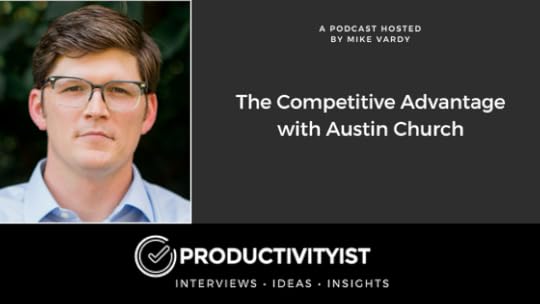
On this episode of the podcast, I spoke with Austin L Church. Austin is the author of children’s books and a consultant who loves helping people build businesses around the work that doesn’t feel like work to them. We spoke about theming, using physical tools to stay on track, keeping things simple and more. It was a great conversation that I think you’ll enjoy.
Here are a few highlights from the show:
Why it’s a great idea to give credit to others (a funny story)
Using notecards
How simplicity is a serious advantage
Focusing on the right things at the right time
Proactively ignoring certain things
Managing complexity
The importance of focusing and finishing
Omission vs. elimination
Why we overestimate what we can do in a day
Overestimating urgency
Abstractions and exceptions
Creating durable plans
Assigning weight to specific tasks based on the day and bigger goals
Relevant Links:
Austin’s Website
Deep Work: Rules for Focused Success in a Distracted World
Eat that Frog: 21 Great Ways to Stop Procrastinating and Get Things Done in Less Time
FOFI Cards
Thanks for listening. If you enjoyed the show don’t forget to subscribe so you don’t miss a single episode. Until next time remember to stop guessing…and start going!
This episode is brought to you by Vast Conference. With the help of their Integrated HD Audio you can ensure that your attendees will have a high-quality and consistent conferencing experience wherever their travels take them. Get a 30 day free trial by visiting https://www.conferencecalling.com/trial30 or by calling one of Vast’s sales reps and mentioning you heard about Vast Conference on The Productivityist Podcast.
The post The Competitive Advantage with Austin Church appeared first on Productivityist.



